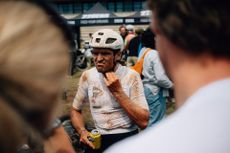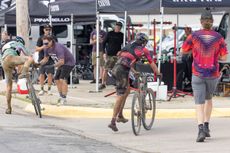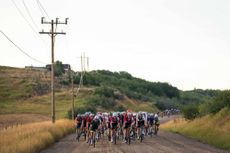'Road racing is notoriously unfriendly' - how women’s participation in gravel cycling is changing the sport worldwide
‘In gravel, everyone's welcome! And I absolutely love that and I never want that to change,' says SBT founder Amy Charity


Around the world, there is momentum to increase women’s participation in sports. But a significant gender gap still exists, particularly in cycling where, according to race promoters, female participation in cycling events is typically between 20-30 percent of registered riders. However, as more attention is being given to women in sport, is it possible that gravel riding is providing the much-needed pathway to increase the number of women in cycling?
In a recent study, researchers in Queensland, Australia, found that female cyclists tend to prefer off-road riding compared to their male counterparts. Compared to road riding, off-road riding, or what most people consider gravel riding, feels more accessible, inclusive, and supportive. The gravel discipline, booming in popularity, provides all people, regardless of age, ability, or gender, an opportunity to get outside and explore. Around the world, event organisers are using the momentum to increase women’s participation in events.
Growing women’s participation in cycling has not been easy. For decades, cycling has been a male-dominated sport, with inequitable media attention and support given to women.
“Road racing is notoriously unfriendly,” says Amy Charity, founding partner and CEO of SBT GRVL and retired professional road racer. “It's hard to feel welcome in a race, even when I was on some of the strongest [road] teams in the U.S. [Road races] are very intimidating, and you always question: Am I doing something right or wrong? Do I belong here? Am I good enough to be here?”
Gravel riding is changing this narrative at both the professional and amateur levels. Races such as SBT GRVL in the United States and The Traka in Spain are integral to this movement, redefining what it means to compete.
“I think that gravel really shifted what cycling can be,” Charity says. “It's what cycling should be. It's still a competition, but there is a community base, and we want everyone to feel welcome.”
In road racing, women’s races are typically shorter than men’s races. For example, the Women’s Olympic Road Race is only 157.6 km compared to the Men’s 273 km race. In contrast, gravel races provide parity for both the men and the women, allowing them to do the exact same course, over the exact same distance, and walk away with the exact same prize money (if money is available). What’s more, is that in gravel, more women are stepping up as Race Directors, including Charity and former professional racers Jess Cerra and Amanda Naumen.
Get The Leadout Newsletter
The latest race content, interviews, features, reviews and expert buying guides, direct to your inbox!
With more than 30 percent female participation at SBT GRVL, Charity’s flagship gravel event is a leading example of what can happen when women feel welcome. In comparison, the average female participation in cycling events sits at around 20%. While SBT GRVL is one of the paramount gravel races for the professional peloton, Charity has built an event that supports every athlete equally with an attitude of:
“Let's be fierce competitors, but let's be friends. And let's help each other, and let's have every single age, cycling background, and fitness level in the same race. Let's all do what we can to get to the finish line.”

While Charity is championing what it means to support women in gravel in the U.S., events like The Traka in Spain are proving that the growth of women’s cycling is happening around the world. Expats and native Spaniards are taking advantage of the thousands of kilometres of gravel roads interconnecting towns and villages across Spain. Maya Noriega, who runs communications for The Traka, explains that around Europe, the amount of women riding gravel is exploding.
“Gravel has been really growing, especially among women, because they just feel safe, and it’s a really nice event,” Noriega says. "There are so many people doing gravel at the moment that there's space for everybody. Everything is public. You grab a route, you’re not afraid of anything happening to you, so you can go by yourself or just with a friend.”
Women’s cycling groups, such as the Girona Gravel Girls or the UK’s Sisters in the Wild, are popping up throughout Europe, spurring the movement to increase accessibility to gravel riding. The groups provide community, support, and an opportunity for adventure. “We're not the same as men,” Noriega says. “We just want to chat, and sometimes [get a] coffee and then don't feel the pressure. There's so many groups and it's really cool to see.”
While adventure is what is bringing women to gravel, the women’s racing scene in Europe is very competitive. Events like The Traka are finding a balance between competitive racing and adventure riding. With over 4,000 participants spanning five different routes, ranging from 50k to 560k, athletes are presented with opportunities to seek adventure or battle it out for a podium spot in the Gravel Earth series.
“I think this year was incredible to see so many [women] doing the 360,” Noriega says. “I think every time they do one distance, they want to go up. So you see them starting with 100, then next year they do 200, and then next year they do 360, and then next year they do the 560. It's a challenge. It's okay, I've done this and I want to try if I can do that. I was really impressed this year at how many females were doing the 360.”
With access to UCI races, adventure races, and endless kilometres of pure adventure riding, Europe is offering something for everyone. But there is still work to do.
In 2023, Charity, along with professional cyclist Tiffany Cromwell and Formula 1 driver Valtteri Bottas, began FNLD GRVL and this year, piloted RADL GRVL in Australia. And while the response to the events has been positive, Charity admits that more needs to be done to increase women’s participation in gravel cycling.
“We're still getting that message out there that you can do this event and you're pinning on a number, but you don't have to be the fastest. You can ride with your friends, and I think that message has been harder to get across in Europe. I wouldn't say it's impossible, but I would also say we're not there yet.”
“How do we increase female representation within the sport?” has been a long-standing question within the cycling industry and one that isn’t going away anytime soon. And while gravel isn’t quite there yet, it’s certainly leading the way. Why?
“I think people are starting to get that [cycling is for everyone],” Charity concludes.

Thank you for reading 20 articles this month* Join now for unlimited access
Enjoy your first month for just £1 / $1 / €1
*Read 5 free articles per month without a subscription

Join now for unlimited access
Try first month for just £1 / $1 / €1

Caroline Dezendorf is an elite off-road cyclist and storyteller with a passion for building community and protecting wild spaces. She lives in Truckee, California, where her backyard is the expansive Sierra Nevada mountains. You can often find her in the mountains, exploring by two wheels or two feet. She aims to inspire future generations to explore the natural world and push beyond their comfort zones.
-
 2,500 children's bikes recalled due to crank failures
2,500 children's bikes recalled due to crank failuresCustomers advised to "immediately" stop using bikes following one report of injury
By Tom Davidson Published
-
 Pas Normal Studios Mechanism Deep Winter Long Bibs review: exceptionally warm tights in a race-fit style
Pas Normal Studios Mechanism Deep Winter Long Bibs review: exceptionally warm tights in a race-fit styleWarm, highly water-resistant bib tights with a supportive pad for long-ride comfort in the winter months
By Andy Turner Published
-
 USA Cycling debuts Junior National Series, offering a unique pathway to elite racing
USA Cycling debuts Junior National Series, offering a unique pathway to elite racingFeaturing the biggest races in the US, the new series offers young talent a dedicated talent development and identification pathway
By Anne-Marije Rook Published
-
 Unofficial Gravel Worlds to offer largest single-day prize purse in the discipline: $100,000
Unofficial Gravel Worlds to offer largest single-day prize purse in the discipline: $100,000With a massive prize purse, a focus on world-class race coverage and staying true to its community focus, Gravel Worlds aims to do more than just keep pace with the growing race scene.
By Anne-Marije Rook Published
-
 Unbound Gravel vs. UCI Gravel: How I'd set up my bike for gravel’s top races
Unbound Gravel vs. UCI Gravel: How I'd set up my bike for gravel’s top racesI tried to make the ideal race steed for both ends of gravel cycling spectrum and got wonderfully lost in the details on the way there
By Logan Jones-Wilkins Published
-
 ‘Nobody cares, work harder’ - how Keegan Swenson muscled his way to gravel dominance
‘Nobody cares, work harder’ - how Keegan Swenson muscled his way to gravel dominanceWith all the big races to his name, he's America’s best gravel racer, and now, he has rainbow stripes in his sight
By Ryan Simonovich Published
-
 ‘I’m still scared of the distance’ - former Roubaix champion Greg van Avermaet on racing Unbound Gravel and life as a gravel pro
‘I’m still scared of the distance’ - former Roubaix champion Greg van Avermaet on racing Unbound Gravel and life as a gravel proFormer Paris-Roubaix champion Greg van Avermaet on conquering Unbound Gravel and life as a gravel pro
By Anne-Marije Rook Published
-
 Enough already with the F1-inspired pit stops in gravel racing, it's time for riders to be self-sufficient again
Enough already with the F1-inspired pit stops in gravel racing, it's time for riders to be self-sufficient againThe spirit of adventure, resourcefulness and inclusivity is diluted to the point where we risk losing sight of the qualities that made the discipline so unique.
By Anne-Marije Rook Published
-
 Rude cyclists, trash and toilets: US ranchers fed up with SBT GRVL and disrespect from riders
Rude cyclists, trash and toilets: US ranchers fed up with SBT GRVL and disrespect from ridersColorado ranchers say significant changes need to be made for SBT GRVL and Colorado agriculture to coexist in peace
By Kristin Jenny Published
-
 ‘I take bike racing seriously’ — Formula One's Valtteri Bottas has sights set on Gravel Worlds in 2024
‘I take bike racing seriously’ — Formula One's Valtteri Bottas has sights set on Gravel Worlds in 2024Sixty-seven-time Formula One podium finisher Valtteri Bottas will add a new challenge to his 2024 schedule: trying to qualify for this year's Gravel World Championships in Belgium in October.
By Kristin Jenny Published